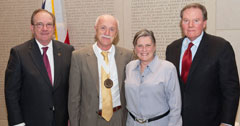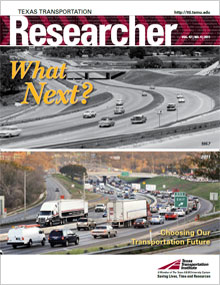TxDOT sees immediate benefits in corridor analysis projects and new lab equipment at TTI
Many roadway segments on Texas highways have exceeded their design lives and are in need of rehabilitation. To assist in this critical task, the Texas Department of Transportation (TxDOT) contracted with the Texas Transportation Institute (TTI) to initiate a groundbreaking corridor analysis project on the I-20 corridor in the Odessa District.
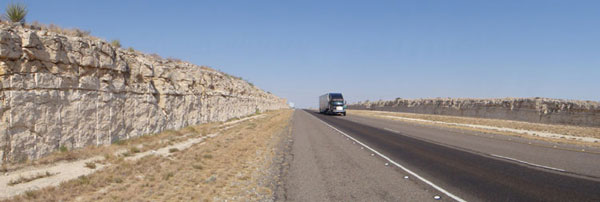
“This corridor studies project is really an in-depth analysis of the existing pavement structure,” says Bryan Raschke, director of operations with the TxDOT Odessa District. “The process looks at the durability and deterioration level of the pavement. Then we can look at that and apply new strategies to roadway reconstruction.”
The research team initially conducted a full ground-penetrating radar survey. Then, after meeting with district personnel to discuss roadway history and priorities, the team executed a falling weight deflectometer test program to evaluate the in situ structural strengths and conducted a verification field-sampling program. For each section, the cause of the distress, the most appropriate repair strategy and the priority of the work were reported to senior district personnel.
“The length of the roadway was 165 miles and consisted of 20 different pavement sections, each with different layer thicknesses and maintenance histories,” says Tom Scullion, the senior research engineer at TTI leading this effort. “The goal of the study was to develop a 10-year pavement rehabilitation plan for each section based on determining the underlying cause of the pavement problems.”
Raschke echoes Scullion’s proactive rehabilitation approach and notes that it has already yielded positive results by allowing district personnel to plan repairs for specific roadway sections.
“A corridor study is a tool that can be used by any of the districts out there,” says Raschke. “It’s looking at what’s there, where the problems are, and just how deep we need to dig to get down to the root of the problem. Then we can address it with a product that will last another 20 years.”
Based on the success of the I-20 project, additional corridor analyses have been completed for I-10 in the Odessa District, US 60 and US 84 in the Lubbock District, and I-45 in the Bryan District. In each study the corridor is broken into projects, and their optimum rehabilitation needs and priorities identified.
The TTI team is currently evaluating the US 59 corridor in the Lufkin District and I-37 in the San Antonio District. This innovative interagency agreement is being directed by TxDOT Pavements and Materials Manager Magdy Mikhail.
McNew Research Laboratory
The Materials and Pavements Division’s McNew Research Laboratory has recently added several new pieces of asphalt testing equipment.
Work over the past 10 years has focused on traditional evaluations of both rutting and cracking potential. The new test provides TTI researchers with additional tools to optimize future surfacing designs.
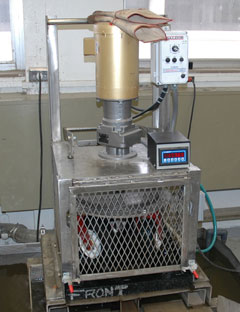
“Our goal is to develop asphalt mixes that optimize friction and decrease roadway noise,” says TTI Recyclable Materials Program Manager Cindy Estakhri. “This equipment allows us to conduct testing in a controlled environment to help us achieve that goal.”
The first step in the process is to manufacture 22-by- 22-inch slab samples using a rolling wheel compactor. These samples can be made from either lab- or plant- produced samples and compacted to the same density as that anticipated in the field.
Three-Wheeled Polishing Device
This device is an automated hot-mix asphalt slab polisher that consists of three pneumatic rubber tires attached to a turntable. The wheels rotate around a circle with an 11.2-inch diameter. The device is also equipped with a water spray to simulate wear from rainfall coupled with tire wear.
In a typical test, 100,000 applications of the tires are applied. During testing the researchers measure the resulting surface friction loss and change in surface texture using the Circular Track Meter and Dynamic Friction Tester. Aggregate and mix combinations that have a tendency to polish under wheel loads are readily identified with this test procedure.
Dynamic Friction Tester (DFT)
The DFT consists of three rubber sliders and a motor that reaches 100 km/h tangential speed. The DFT system can be used to measure friction characteristics of laboratory manufactured samples. The test is started while the rotating disk is suspended over the pavement and driven by a motor to a particular tangential speed.
Water is sprayed on the rubber pad and pavement interface through surrounding pipes to simulate wet weather friction. Then the disk is lowered, and the motor is disengaged. Researchers determine surface friction by measuring the traction force in each rubber slider. Studies at TTI have found that by combining the CTM and DFT data, it is possible to accurately predict the friction in the field that would be measured by an ASTM skid trailer.
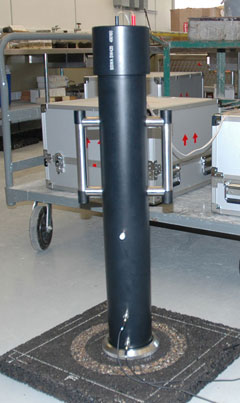
Circular Track Meter (CTM)
The CTM is a laser-based device used to measure the depth of a pavement surface. It uses a charged coupled device laser to trace the profile of a circle 11.2 inches in diameter, the same size as the three-wheeled polishing device. The profile is divided into eight segments, and the texture depth of the surface is reported as the average profile depth of these eight segments.
Impedance Tube
The impedance tube is used to measure roadway noise. The tube is placed on top of a test section; then a white noise pulse is sent down the tube, and the resulting “echo” is measured.
“What we are looking for during this test is how quiet the roadway is,” says Estakhri. “A certain percentage of voids on the surface of the asphalt test section is desirable to absorb the noise, rather than reflect it.” Quiet roadway surfaces are a major concern especially in big cities where often the U.S. Department of Transportation is forced to build very expensive noise walls to mitigate the traffic noise problems. TTI researchers are busy formulating the next generation of low-noise, long-lasting permeable pavement surfaces. The laboratory impedance tube will be a major tool in this design process.
